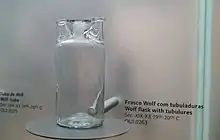Peter Woulfe
Peter Woulfe (1727–1803) was an Irish chemist and mineralogist. He first had the idea that wolframite might contain a previously undiscovered element (tungsten).[1][2]
Peter Woulfe | |
|---|---|
 | |
| Born | 1727 |
| Died | 1803 |
| Nationality | Irish |
| Awards | Copley Medal (1768) |
| Scientific career | |
| Fields | Chemistry mineralogist |
In 1771, Woulfe reported the formation of a yellow dye when indigo was treated with nitric acid.[3] Later it was discovered by others that he had formed picric acid, which eventually was used as the first synthetic dye, an explosive and an antiseptic treatment for burns.
Woulfe is credited with inventing, ca. 1767, the Woulfe Bottle, an apparatus for purifying or dissolving gases, which employed a bottle with two or three necks.[4]
Alchemy
Woulfe has been described as being as much an alchemist and mystic as a scientist. As recorded by John Timbs:[5]
"The last true believer in alchemy was not Dr. Price, but Peter Woulfe, the eminent chemist, and Fellow of the Royal Society, and who made experiments to show the nature of mosaic gold [ tin(IV) sulfide, SnS2]. […] He had long vainly searched for the Elixir, and attributed his repeated failures to the want of due preparation by pious and charitable acts. I understand that some of his apparatus is still extant, upon which are supplications for success and for the welfare of the adepts."
References
- Timbs, John (1866). English Eccentrics and Eccentricities. vol.1. [S.l.]: Chatto & Windus. OCLC 500018598.
- . Dictionary of National Biography. London: Smith, Elder & Co. 1885–1900. OCLC 11414779
Notes
- Woulfe, Peter (1779). "Experiments on some mineral substances". Philosophical Transactions of the Royal Society of London. 69: 11–34. doi:10.1098/rstl.1779.0004. S2CID 186212561. On pages 29–34, Woulfe analyzed a sample of a mineral from Joachimsthal (now: Jáchymov, Czech Republic) (see p. 30). On p. 31, Woulfe stated that the mineral contained "a new earth", and on pp. 32 and 34, he stated that it contained "some other earth".
- http://limerickslife.com/peter-woulfe/
- See:
- Woulfe, Peter (1771). "A method of dying wool and silk, of a yellow colour, with indigo; and also with several other blue and red colouring substances". Philosophical Transactions of the Royal Society of London. 61: 127–130. doi:10.1098/rstl.1771.0015.
- Hartog, Philip Joseph (1885–1900). "Woulfe, Peter". Dictionary of National Biography. vol. 63. London, England: Smith, Elder & Co. p. 64.
- See:
- Woulfe, Peter (1767). "Experiments on the distillation of acids, volatile alkalies, &c. shewing how they mayt be condensed without loss, and how thereby we may avoid disagreeable and noxious fumes: in a letter from Mr. Peter Woulfe, F.R.S. to John Ellis, Esq.; F.R.S." Philosophical Transactions of the Royal Society of London. 57: 517–536. Bibcode:1767RSPT...57..517W. doi:10.1098/rstl.1767.0052.
- "Woulfe, Peter", Dictionary of National Biography, 1885-1900, 63 : 63–64.
- Webster's Revised Unabridged Dictionary 1913
- Timbs, John (1866). English Eccentrics and Eccentricities. vol. 1. London, England: Richard Bentley. pp. 136–137.
External links
- Woulfe bottles (twonecked and threenecked); The Jagiellonian University Museum at the Wayback Machine (archived March 9, 2008)
